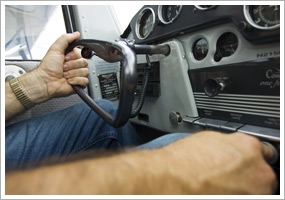training tips  Control effectiveness Control effectiveness The March 18 Training Tip discussed problems that a student pilot may encounter from not being confident enough to manipulate the controls as needed to complete a maneuver. The opposite problem—overcontrolling, typically as over-rotating on takeoff—also is cured through correlating knowledge gained during slow-speed flight drills with operating in the low-speed realm of everyday flying. Over-controlling also may be a sign of stress masquerading as a lack of understanding of flight fundamentals. Lick both problems by developing a good feel for your trainer’s range of control effectiveness. Start by associating the physical sensations of flight with timing of your control inputs. As you begin a takeoff run, sense the increased responsiveness of the flight controls to acceleration. It’s said that the controls seem to “come alive” through the yoke and pedals as air flows ever faster over ailerons and elevator, and around the rudder. It will take less yoke or pedal pressure to produce any given aircraft response as airspeed increases. By the time you reach normal rotation airspeed, expect aircraft response to be firm and unhesitating. Pitching to the desired attitude should take modest, gentle physical effort, not a mighty tug on the yoke. Be patient. If the aircraft does not leave the ground immediately, it doesn’t mean that you must haul back more. In a few seconds the accelerating aircraft should ease away from the ground. Then you can focus on establishing and trimming for best rate of climb speed (V Y). A mechanical item to check on any well-used trainer that may be preventing your best efforts from being fully rewarded is control cables that have become slack. “One of the most irritating control-system characteristics is slack, a condition where initial control movement does nothing but cause a wiggle in the wheel,” wrote AOPA Pilot columnist Barry Schiff in his June 2003 Proficient Pilot column. “You can determine the amount of play in the cables when on the ground by having someone hold a control surface firmly in place while gently attempting to move the control wheel or stick against the applied force. If slack is present, it might be eliminated by having the turnbuckles in the control path tightened during the next annual inspection.” Learn the feel, and then get a smooth, predictable aircraft response every time. training products ‘The Aviators’ first season on DVD If you’ve been hunting for The Aviators on your local public television station and have been unsuccessful at finding this show on all things aviation, Sporty’s has the first season on DVD. The collection includes 13 episodes on two DVDs. Purchase it online for $29.95. Note: Products listed have not been evaluated by ePilot editors unless otherwise noted. AOPA assumes no responsibility for products or services listed or for claims or actions by manufacturers or vendors. final exam Question: What should I do if I get lost on a cross-country flight? Answer: First, don’t panic. Many of us have not been sure of our position once or twice during our flying careers. Staying calm and doing what you’ve been taught is the key to a successful outcome. Make sure you fly a specific heading in the direction you believe is correct. If you have been diligent about staying on course, you’re probably not too far from where you should be. Look around and try to identify features on the ground like rivers, mountain ranges, or major highways. Also, if there are several VORs in the area you can use them for a cross-bearing to locate your position on the sectional chart. There is also the option of flying to the station. At least then you’ll know exactly where you are. Of course, if you have a GPS hopefully you know how to use it. The direct-to button and/or the nearest button are great features when you’re lost. If you still can’t figure out your location, follow the “four Cs”: climb, communicate, confess, and comply. For more procedures to keep you safe, read “In-Flight Safety Review” from the January 2000 Flight Training. Got a question for our technical services staff? E-mail [email protected] or call the Pilot Information Center, 800/872-2672. Don’t forget the online archive of “Final Exam” questions and answers, searchable by keyword or topic. | 


